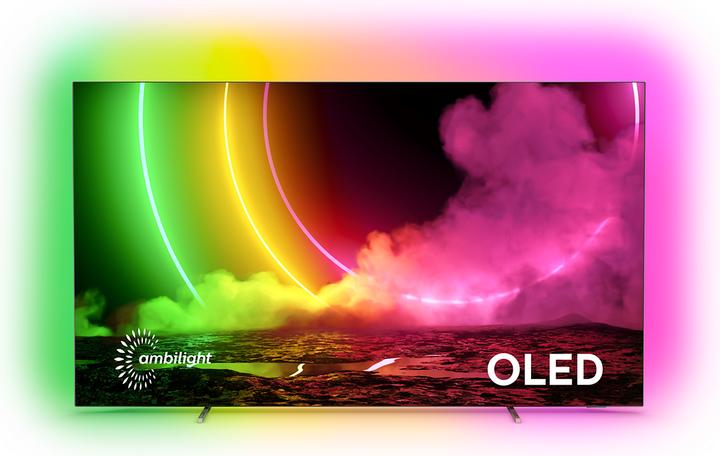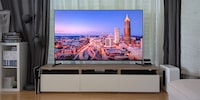

TV review: the Philips OLED 806 is now good for gaming!
First things first: with this OLED TV from Philips, gamers now also get their money’s worth. What’s more, previous shortcomings have been stamped out, and four-sided Ambilight and Google TV have been added. Suffice it to say that I enjoyed testing this TV.
Sometimes Philips is a mystery to me. Take its strategy for launching new TVs, for instance. Most manufacturers time their new launches for spring. But not Philips. Philips does nothing. Phillips takes its sweet time. And, in return, Philips gets all the attention later. Mystery solved!

For all sizes, click here!
Finally, the Philips OLED 806 has found its way into my hands for testing. Was it worth the wait? You bet. The Dutch TV manufacturer has not only eliminated old weaknesses, but finally has its sights set on a new target:
Gamers.
A new gaming TV on the horizon
Full disclosure: the 65-inch TV was provided to me by Philips, just like last year. At the time, I criticised the OLED 805’s predecessor for being unsuitable as a gaming TV. It didn’t have HDMI 2.1. Gamers were left hanging.
«The TV isn't intended for gamers.»
To take full advantage of next-gen consoles, a lot of bandwidth is required between the TV and console. This is the only way to transfer the large amounts of data that gaming causes fast enough. Because the previous-generation Philips TV with its outdated HDMI 2.0 lacked the necessary bandwidth, there was a high input lag.
Gamer folk, listen up: the times they are a-changing! Philips has done its homework: the OLED 806 offers two HDMI inputs with full 48 Gbit/s bandwidth. The only thing I disabled in the settings is the annoying sensor that adjusts the screen’s brightness based on room brightness; it still doesn’t work reliably, even in the latest model.
So, is the TV good for gaming? Absolutely. In fact, I can recommend it for several reasons. Namely, fast response times typical to OLED pixels, VRR and FreeSync Premium. Philips – like LG, Samsung and Panasonic – has entered into a partnership with many large gaming studios as part of the HGiG, or HDR Gaming Interest Group. According to the manufacturer, this should ensure that HDR is displayed as the game developers intended. PC gamers in particular can tell you a thing or two about this.
Game: «Spider-Man: Miles Morales», played on the PS5, at 4K60 Hz and with ray tracing.
I measured a very good average input lag of 15 milliseconds with the Leo Bodnar input lag tester. That’s about half as much as the predecessor, and I didn’t notice any serious losses in picture quality when playing «Spider-Man: Miles Morales», for example.
I’m satisfied: the colours are bright, black really is black, the edges look sharp and the picture isn’t too blurred during fast camera pans. Look out for Miles’ dark silhouette against the light, the detailed textures of snow-covered New York and the detail in the clouds, which have very high brightness values. This is what a good game mode looks like.
The ports also look good:
- 2× HDMI 2.1, one with eARC (4K120Hz)
- 2× HDMI 2.0b with ARC (4K60Hz)
- All inputs support HLG, HDR10, HDR10+, Dolby Vision and Dolby Atmos.
- 1× Toslink output
- 3× USB 2.0 ports
- 1× LAN port
- 802.11ac Wi-Fi, 2×2 dual band.
- Auto Low Latency Mode (ALLM) for gamers
On to image quality.
Previous shortcomings are gone: no more black crush
Last year’s Philips OLED 805 had another weakness: too much black crush. Black crush refers to a loss of details in the dark areas of an image – the details are «crushed» by OLED’s perfect black. The 805’s performance in standard picture mode was a complete failure. When I switched to AI picture mode, where the TV processor adjusts the image frame by frame based on metadata, the dark areas looked a bit less gloomy – but still not perfect.
Here’s an example from «Jurassic World: Fallen Kingdom».

Source: Disney+, «Guardians of the Galaxy, Vol. 2». Timestamp: 01:14:08. Quality: UHD, Dolby Vision.
Philips has not only improved the AI mode on the 806, but abolished the standard mode altogether. Good. You’re not missing out on anything. No matter in which quality you watch content, the AI is now always optimising the image in the background without you having to turn it on in the settings beforehand.
You can immediately see the drastic reduction in black crush as a result. Here’s the same scene as above:
Look at the runway in the foreground. Or the details on the lower fuselage of the aircraft. It’s like night and day. And «Jurassic World: Fallen Kingdom» isn’t just an example of the black crush I experienced before, but the rule. Well done fixing that, Philips.
The – once again – very good colour reproduction is another rule. This comes as no surprise if you look at the specs on Display Specifications: 99 per cent of DCI P3 is covered, which is the colour space most often used in HDR content by Hollywood colourists. This puts the Philips 806 on par with the LG OLED G1’s (99 per cent) and slightly above the Sony A90J’s (97 per cent) or the Samsung QN95A’s (95 per cent).
You can really see the difference – be it when watching Disney’s latest treat of an animation «Encanto» or Marvel’s blockbuster «Guardians of the Galaxy». The latter is especially well suited to test a TV’s colour reproduction. From the breathtaking and all-outshining golden world of the Sovereign to the fantastic colour kaleidoscope of the living planet Ego, the ensemble of human, alien, raccoon and tree is at least as motley as the film. I mean, look at this:

Source: Disney+, «Guardians of the Galaxy, Vol. 2». Timestamp: 01:14:08. Quality: UHD, Dolby Vision.
Look at the blades of grass covering the picturesque red planet. Or the sun in the background, hovering between the turquoise-blue sky and the orange-yellow twilight. It even retains its spherical shape, which speaks for good brightness gradation.
Again, a solid processor
Let’s talk about the processor: the brain of the TV. Its main task is to receive, process and then display image signals. In this context, processing means recognising poor image quality and enhancing it. Philips calls its processor the «P5 Perfect Picture Engine» with AI. Marketing gobbledygook aside, the processor is supposed to remove noise, enhance colours, smooth edges, make movements more fluent and add any missing pixel information.
Pixel response time
to test pixel response times, I start with an Apple Original: «For All Mankind». I want to see how long a single pixel takes to change colour. You can tell if the pixels aren’t changing colour fast enough when the image looks smeared – so-called ghosting. Here’s a comparison of the Philips 806 with the TCL C82, a mini-LED TV. When the camera pans over the surface of the moon, pay attention to the superimposed text. On the TCL, you can see ghosting.
Source: Apple TV+, «For All Mankind», Season 1, Episode 5. Timestamp: 00:00:10. Quality: UHD, Dolby Vision.
The result doesn’t surprise me. OLED TVs have excellent response times, which results in less ghosting. That’s why they’re also considered exquisite gaming monitors. LCD TVs are at a disadvantage in this respect.
Motion smoothing and judder
For this test, I want to make the processor sweat. My goal is to examine judder on the Philips OLED 806. All TVs have judder, which occurs when the image signal and TV panel don’t have the same refresh rate. Take movies: the Panasonic 806 can display up to 120 frames per second – but movies are filmed at 24 frames per second. Processers synchronise the differing frame rates using a feature called frame interpolation, or motion smoothing. If the processor is too aggressive, the picture looks too fluid – like in a kitschy soap opera. But if the processor is too conservative, it results in image stutter. This effect is especially visible in long camera pans. It makes the movie appear shaky, or juddery – hence the term «judder».
Sam Mendes’s «1917» is full of such steady, slow-flowing camera movements, making it perfect for the judder test. The video below shows a comparison of the Philips OLED 806 with the Panasonic JZC 2004, the LG G1 and the Samsung QN95A. Pay attention to the vertical bars in the barn as the camera pans.
Source: UHD Blu-ray, «1917». Timestamp: 00:42:25. Quality: UHD, Dolby Vision.
How the Philips processor deals with motion is spectacular: the image is extremely fluid, and there’s hardly any judder. However, purists might actually find it too fluid, too cheap; a movie is supposed to be a bit jerky. Vintage. On the Panasonic and Samsung, on the other hand, there’s too much stutter – not to mention quite a bad case of ghosting in the vertical bars. In my opinion, the LG G1 offers the sweet spot: you can see some judder if you pay close attention, but it’s never grating.
There’s another scene from «1917» that showcases this nicely. Again, Mendes’ camerawork constitutes an immense challenge for most processors. Hard edges in front of a blurred background – like the helmets of the two soldiers below – present a particular challenge. Both the processor and pixels have to react incredibly fast. I’ve also included footage from the Sony A90J this time:
Source: UHD Blu-ray, «1917». Timestamp: 00:35:36. Quality: UHD, Dolby Vision.
You can really see Sony’s muscle flex in this scene: the image is fluid, yet never looks unnatural. The colour is also on point: hard, cold and sullen like the scenery, yet it never looks unnatural either. Personally, I prefer the warm colour preset on the LG G1, though the Sony probably comes closer to what colourists in Hollywood intended. Philips falls a bit behind in this comparison.
Upscaling
Time for the final test. II want to see how well the TV’s processor upscales lower quality material such as Blu-ray or live television. Or, even better: «The Walking Dead». The series was deliberately shot on 16 mm film to preserve the old-fashioned grain that creates the feeling of a broken, post-apocalyptic world.

Source: Netflix, «The Walking Dead», Season 7, Episode 1. Timestamp: 00:02:30. Quality: UHD, Dolby Vision.
The Philips P5 processor has got upscaling down. Nuff said. That up there is an SDR-quality HD image with about 2 million pixels – blown up to 8.3 million pixels. In other words, 75 per cent of the image has been supplemented by the processor.
And now compared to the LG:

Source: Netflix, «The Walking Dead», Season 7, Episode 1. Timestamp: 00:02:30. Quality: UHD, Dolby Vision.
My very good first impression holds up: I need a magnifying glass to see any differences in sharpness, noise and edge smoothing. The only thing that immediately catches my eye is the significantly warmer colour temperature ion the LG. However, this has nothing to do with processor performance per se, but with its factory calibration.
By the way, Samsung proves that not all upscaling is made equal. Let me put it this way: –the makers of «The Walking Dead» would really get a kick out of this image; it’s as grainy as a snowstorm.

Source: Netflix, «The Walking Dead», Season 7, Episode 1. Timestamp: 00:02:30. Quality: UHD, Dolby Vision.
There’s another problem: the scene pictured above takes place in a forest at night. So, the background should actually be a lot darker. Samsung’s processor obviously doesn’t understand that the shadows don’t need to be brightened so much. Instead, the processor brings to light the little image information it has and interprets it as graininess.
As you can see, a good processor maketh the TV.
What about Google TV, Ambilight and audio quality?
A few weeks ago, the Philips OLED 806 received an update for a new operating system: Google TV. Thank heavens! I never was a fan of the slow and poorly programmed predecessor. Even on high-end TVs with powerful processors, the controls were fiddly. Not to mention the slow-loading apps, bugs and constant crashes. A nightmare.
Google TV
I’m pleased that Android TV seems to be dying out slowly but surely. The new Google TV interface is much cleaner, displays cross-app suggestions, and can be operated without noticeable lag. The apps load quickly, I practically never experience crashes, and Google Chromecast is a given. What this means is you can stream almost any content, media, and apps from your smartphone to your TV – your recent vacation photos, for example.
4-sided Ambilight
Ambilight has also been updated. Ambilight is an exclusive feature by Philips. There are LEDs at the back of the panel which – matching the picture – illuminate the wall behind the TV. The Philips OLED 806 has these LEDs mounted not only on the side and on the top edge, but also on the bottom. Hence, 4-sided Ambilight.
Here’s what it looks like with the colourful animated film «Encanto»:
Source: Disney+, «Encanto». Quality: UHD, Dolby Vision.
If you don’t like the flickering behind the TV, you can turn it off completely. It seems unlikely that anyone would turn it off, though. After all, Ambilight is the big unique selling point of a Philips OLED – and can even be integrated into an existing Philips Hue system. And it’s also great outside of movies and series. Let me give an example: when having guests over, I can play background music on my TV. Thanks to Ambilight, the LEDs light up to match the song. Surely that’s better than just having a black, rectangular hole?
Audio – good enough
As for the audio quality: it’s not bad at all. I wouldn’t necessarily put that down to the two 10-watt speakers. I think it’s more to do with the additional 30-watt woofer integrated into the panel. It's got a nice bounce and fills the room well. This makes the audio much less tinny and hollow than I had initially feared. The TV also supports cinema sound formats like Dolby Atmos and DTS-HD. However, this TV can’t replace a real home theatre system – no TV does that, except maybe Sony’s OLEDs with Acoustic Surface technology.
Verdict: the best Philips TV to date
Philips OLED TVs are good. In terms of picture quality, they’re among the best TVs available on the market. And there’s fierce competition. Now, this alone isn’t news. But the following two points make all the difference:
- Philips has weeded out old weaknesses, notably black crush.
- Philips OLED TVs now also make great gaming TVs.
Not to toot my own horn, but it’s as if the Dutch had read my review from last year and said: «This year, we’re creating a TV that will fully satisfy even Luca.» The AI mode rocks. The image is crisp and sharp – and colours are bright but never unnatural. And the powerful processor conjures up a good picture even from a bad-quality source. It’s a dream come true.
I write about technology as if it were cinema, and about films as if they were real life. Between bits and blockbusters, I’m after stories that move people, not just generate clicks. And yes – sometimes I listen to film scores louder than I probably should.



